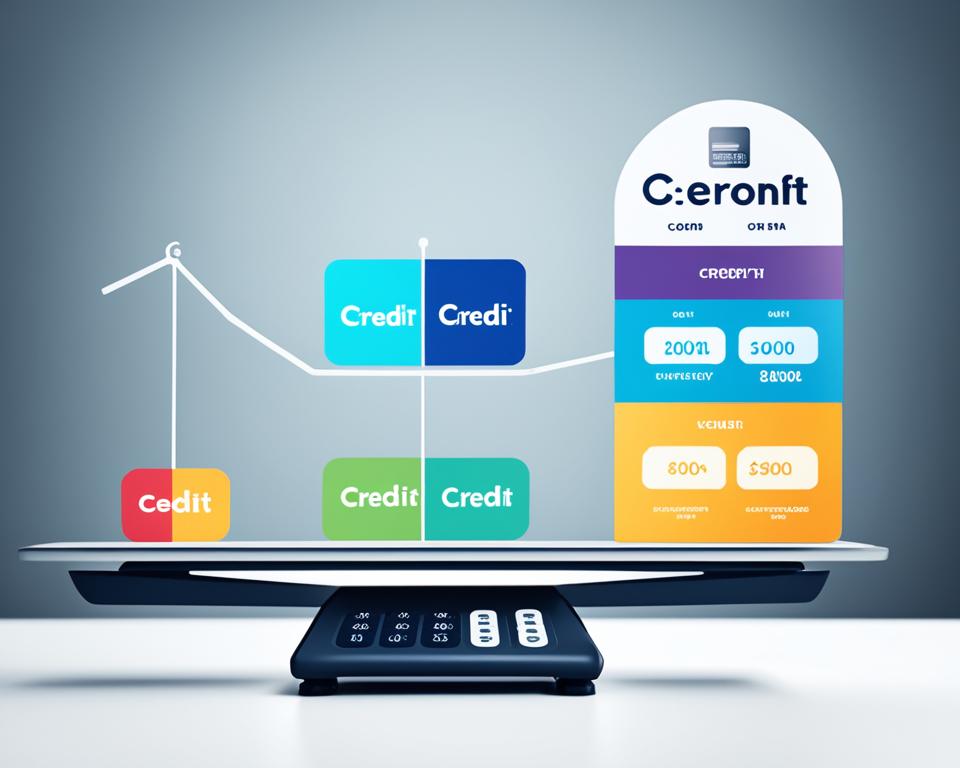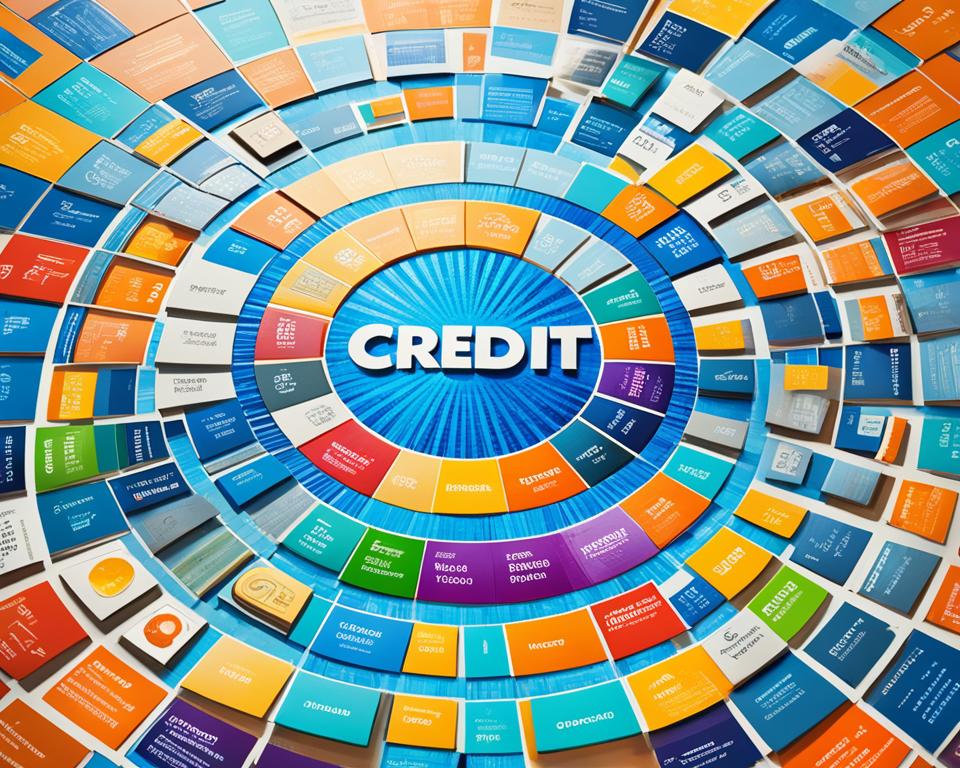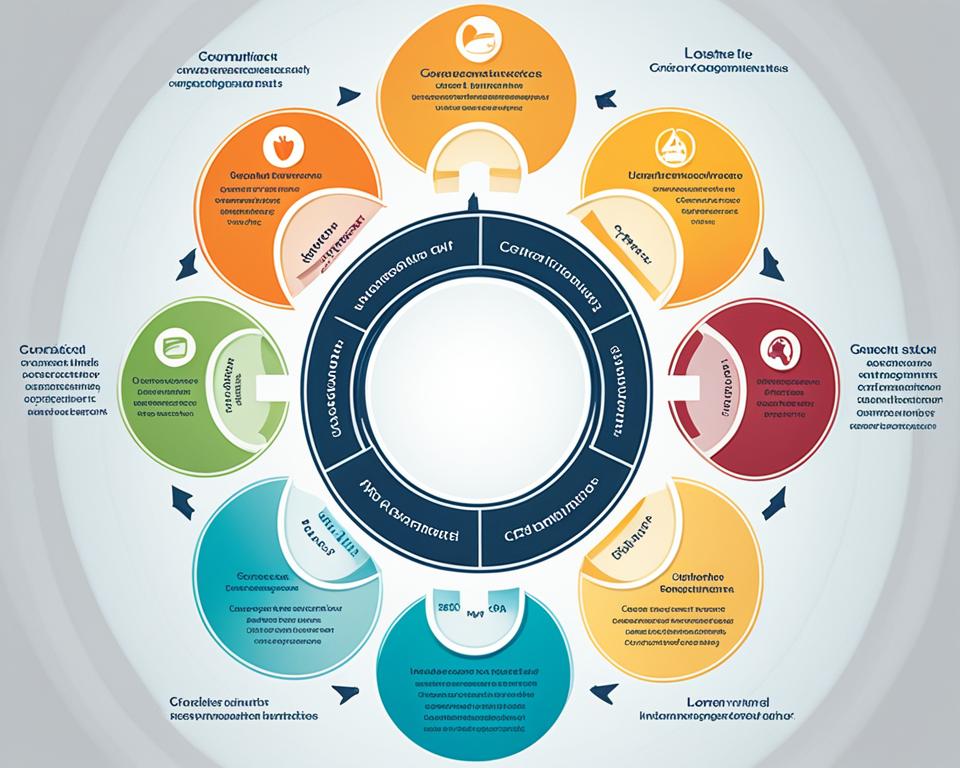Retaining a robust financial health requires a multifaceted credit portfolio management approach. Astute individuals recognize that a single credit form is a shaky foundation to rely on. It is through diversifying your credit portfolio that one can strengthen their financial resilience and flexibility. A diversified credit arrangement underpins a solid investment strategy, cushioning against market vicissitudes and credit score fluctuations. By incorporating a variety of credit types—from secured credit cards to installment loans—borrowers can shore up their credit standing and prepare for future financial opportunities.
Key Takeaways
- Diversification extends beyond investments to encompass credit sources for holistic financial health.
- An eclectic credit portfolio serves as a bulwark against fiscal turbulence, enhancing creditworthiness.
- Embracing varied credit tools is a proactive credit portfolio management technique, catering to diverse financial backgrounds.
- Secured credit cards and installment loans are pivotal in crafting a resilient and flexible credit report.
- A strategic investment approach in credit diversification ensures a robust financial footprint while mitigating risks.
Understanding Credit Diversification
In today’s dynamic financial landscape, the path to sustainable financial health is rarely linear or one-dimensional. A critical component often overlooked is the multidimensional nature of credit. Here’s where credit diversification plays a key role. Incorporating a mix of different credit types into one’s financial portfolio is not a mere chance operation but a careful strategy aimed at improving risk management and bolstering credit standings. Let’s delve deeper into why a diverse credit mix is essential and how varying credit types can impact your financial health.
The Importance of a Diverse Credit Mix
A credit portfolio flaunting a blend of installment loans and revolving credit is like a garden with an abundance of flora. Just as biodiversity in an ecosystem fosters resilience and growth, a varied credit mix demonstrates an individual’s dexterity in managing multiple forms of debt. Credit scoring models, like FICO, place significant weight on this aspect, reinforcing the fact that a salient credit diversification strategy can elevate one’s creditworthiness.
How Different Credit Types Affect Your Financial Health
Credit cards, when wielded with sagacity, serve as revolving lines of credit that can adapt to our fluctuating financial needs. On the flip side, installment loans provide a structured payment approach toward a definitive financial goal. The interplay of these diverse credit types engenders a harmonic balance, reflective of meticulous financial health and sound risk management. It’s a concerto of fiscal responsibility, where each credit instrument, when played correctly, contributes to the symphony of a well-rounded credit score.
Secured Credit Cards as a Credit-Building Tool
Embarking on the path to a solid financial future often starts with the establishment of credit. A secured credit card emerges as an indispensable ally in this journey, offering a gateway to credit portfolio management and a more favorable credit score. This particular credit type demands a cash deposit which serves as collateral to secure the line of credit. This secured investment not only mitigates risk for lenders but also creates an environment in which cardholders can demonstrate financial reliability.
Constructed as groundwork for new creditors and those with less than ideal credit histories, secured credit cards are pivotal in nurturing a credit foundation. Users who ensure timely payments may find themselves rewarded with increased credit limits and stronger credit profiles. These enhancements are contingent upon the reporting of payment behaviors to major credit bureaus, an integral function furnished by secured credit cards which distinguishes them from their prepaid counterparts.
Navigating the landscape of secured credit cards necessitates informed decisions. Consumers aiming to strengthen their credit trajectories can start by selecting esteemed financial institutions – opting for a well-regarded bank or credit union is instrumental. This decision is not solely a matter of brand recognition; such institutions must report to all three major credit bureaus to truly fortify a cardholder’s credit standing.

Consider, for instance, the Capital One Platinum Secured Credit Card. Not only is it accessible to various levels of credit histories, but it also offers the potential for a credit limit increase after a succession of on-time payments—a testament to the institution’s commitment to credit-building.
Here is how the Capital One Platinum Secured Credit Card compares to other credit-building tools:
| Credit Tool | Deposit Required | Credit Reporting | Opportunity for Limit Increase |
|---|---|---|---|
| Capital One Platinum Secured Credit Card | $49, $99, or $200 | Reports to all three major bureaus | After five on-time payments |
| Typical Secured Credit Card | Usually $200 | Varies by institution | Based on creditworthiness |
| Prepaid Debit Card | Varies by load amount | Does not report | Not applicable |
The choices made in the realm of secured credit cards can have far-reaching effects in one’s financial narrative. Timeliness and responsibility fortify not just creditworthiness but also personal finance mastery—a cornerstone of modern economic resilience. While the journey of credit elevation can be intricate, wielding the power of a dedicated credit portfolio management approach with the right tools unlocks a future ripe with possibility.
Adding Installment Loans to Your Credit Portfolio
The essence of a well-rounded credit portfolio lies in its diversification. Beyond merely revolving credit, such as credit cards, installment loans form an integral component that enriches your financial narrative. Be it for a mortgage, a car, or education, installment loans underpin the structure of a sound credit mix, showcasing an individual’s financial discipline in managing long-term debts.
Engaging in credit portfolio management entails understanding the nuances of different financial products and their role within your credit history. Among these, installment loans account for a significant proportion, not merely as debt obligations but as tools for credit augmentation.
The Role of Installment Loans in Credit Mix
Installment loans inject a level of variety into your credit portfolio that revolving credit alone cannot provide. By integrating these loans, you are afforded the opportunity to establish a track record of consistent, on-time repayments – a factor that credit bureaus weigh heavily. This demonstrates to potential lenders your capability to handle various types of financial obligations effectively.
How Consistent Payments Boost Credit Scores
Punctuality is the linchpin of credit score improvement, especially concerning installment loans. These fixed, monthly payments, when fulfilled on schedule, contribute positively to your credit history. Regularity speaks volumes about your reliability, which can gradually fortify your credit score – reflecting nearly 10% of your FICO score calculation. This diligent pattern is a clear testament to your sound credit portfolio management practices.
Alternative Credit: Credit-Builder Loans
In the quest for credit diversification, credit-builder loans present a promising avenue for consumers looking to enhance their credit profiles. Unlike traditional forms of credit, these innovative financial instruments offer a novel means for building credit responsibly. As this sector burgeons, one name stands out: Self Lender. This digital platform has been instrumental in propelling many towards better financial health without the immediate financial burden generally associated with building credit.
Exploring Self Lender for Credit Growth
Self Lender has carved a niche in the financial services realm as a provider of credit-builder loans. The essence of its program lies in its simplicity and accessibility: it allows users to save money while concurrently building credit. Once approved, the loan amount is deposited into a Certificate of Deposit (CD) that is FDIC insured, marking the beginning of a borrower’s credit-building journey. The borrower then makes monthly payments towards the loan, which are reported to all three major credit bureaus, laying the foundation for a solid credit score.
The Advantages of a Credit-Builder Loan Over Secured Cards
While secured credit cards have commonly been a go-to for building credit, credit-builder loans like those from Self Lender offer distinct advantages. One of the most notable differences is the lack of a required deposit upfront. Users of secured cards must provide a cash deposit, which generally serves as their credit limit. In contrast, credit-builder loans do not impede a user’s cash flow at the outset. Once the loan term concludes and the borrower has fully paid the loan, the sum in the CD is unlocked and returned to them, often with accrued interest. This positions credit-builder loans not just as a means for credit growth but also as a savings mechanism.
The benefits of choosing credit-builder loans through Self Lender include:
- No initial deposit required, easing financial strain
- Structured repayment plan aiding in budget discipline
- Payment activities reported to all major credit bureaus
- End-of-term savings plus interest earned on CD
By integrating credit-builder loans into one’s credit strategy, individuals can experience an upward trajectory in their credit scores while nurturing a habit of saving. Self Lender thus offers a comprehensive solution for those seeking to establish or rebuild their credit histories, marking a significant step towards enhanced financial empowerment.
Benefits of Becoming an Authorized User
In the realm of credit portfolio management, becoming an authorized user on someone else’s account is akin to being granted a key to the vast library of credit history. It is an essential strategy for enhancing your credit mix and bolstering your overall financial health. This relationship in credit not only allows for educational insight into managing finances but can also be a stepping stone for building one’s own credit reputation.
Let’s explore the potential advantages when one is added as an authorized user to an established credit account:
- Credit History Lengthening: As an authorized user, the account’s credit history is often retroactively applied to your credit profile, potentially expanding the length of your credit history, which is a vital component of a credit score.
- Improved Credit Utilization: If the primary account holder maintains a low credit utilization ratio, this practice can positively impact your credit utilization metric, a critical factor in credit scoring algorithms.
- Payment History Benefits: On-time payments made by the account owner are reflected on your credit report, contributing to a positive payment history.
- Credit Score Enhancement: All these factors combined can lead to a higher personal credit score, provided the primary account holder’s credit habits are sound and prudent.
However, it’s crucial that the person extending the authorized user privilege has a steadfast record of on-time payments and maintains a low utilization rate. The impact of their financial behavior on your credit can be double-edged.
| Authorized User Status | Impact on Credit Portfolio |
|---|---|
| Positive Payment History | Can significantly uplift the user’s credit score |
| High Credit Utilization | Potentially detrimental to the user’s credit score |
| Long-Standing Account | Enhances the length of credit history for the user |
| Financial Missteps | Can adversely affect the user’s credit standing |
Being an authorized user requires judicious selection of the account holder and an understanding that while you can enjoy the benefits, you are also subject to the contingent risks. It’s a tool within credit portfolio management that when used wisely, can pay dividends towards establishing and preserving robust financial health.
Capital One Products and Your Credit Journey
Embarking on a credit journey can be a complex endeavor, yet it is an essential part of personal finance management. As consumers seek to establish or rebuild credit, choosing the right tools and partners for this journey becomes paramount. Among the plethora of financial institutions, Capital One stands out as a leading provider of products designed to guide individuals along the path of credit improvement and credit portfolio management.
Security Deposits and Credit Limits: A Balancing Act
Key to this process is the concept of security deposits — a feature typically associated with secured credit cards. Such cards, including the Capital One Platinum Secured Credit Card, allow consumers to secure a line of credit by providing a deposit that acts as collateral. This deposit reassures the lender while enabling customers to demonstrate their creditworthiness through controlled spending and repayments.
In the world of credit, the balance between what you can borrow and what you are allowed to borrow—credit limits—is a delicate dance. Capital One recognizes this and has structured its secured cards in a way that rewards customers’ fiscal responsibility. Provided that an individual can make a manageable security deposit, they are given the opportunity to prove themselves through responsible credit use.

Capital One: Elevating Your Credit with Timely Payments
Capital One encourages and incentivizes timely payments. Paying your credit card bill on time is one of the most significant contributors to a healthy credit score. As part of effective credit portfolio management, maintaining a punctual payment record with a Capital One product can lead to credit limit increases—a sign of enhanced trust and improved creditworthiness.
With products designed for those just starting out or those with an average credit score, Capital One provides a springboard for credit journeyers. The absence of an annual fee eases the financial burden, while the prospect of increased credit limits after five months of on-time payments adds to the appeal, showing Capital One’s dedication to helping its customers grow their credit.
Below is a snapshot of how a Capital One secured card compares to other credit-building instruments:
| Feature | Capital One Platinum Secured Credit Card | General Secured Credit Cards |
|---|---|---|
| Annual Fee | $0 | Varies |
| Minimum Security Deposit | $49, $99, or $200 | Typically equal to credit limit |
| Credit Reporting | Yes, to all three major bureaus | Depends on the issuer |
| Opportunity for Credit Limit Increase | After five on-time payments | Varies by issuer and creditworthiness |
All in all, Capital One’s approach to credit tools, revolving around security deposits and the potential for increased credit limits, enables customers to take charge of their credit journey. By fostering responsible spending and repayment habits within their credit portfolio management, individuals can enhance their credit profile and work towards a more secure financial future.
Assessing Your Current Credit Mix
When it comes to personal finance, understanding the composition of your credit can be just as critical as portfolio allocation in the investment world. Regular assessment of your credit mix is a crucial aspect of credit portfolio management, offering substantial diversification benefits to your financial health. A balanced blend of revolving and installment credit suggests to lenders a level of sophistication and prudence in managing diverse financial obligations.
An ideal credit mix comprises a judicious balance of credit cards, mortgage loans, auto loans, and perhaps a student loan or two. This indicates to credit bureaus and potential lenders that an individual is adept at handling both the flexible repayment terms of revolving credit and the fixed installments associated with loans. As a part of broader portfolio allocation strategies, a diversified credit portfolio equips you with the flexibility to adapt to financial demands while potentially enhancing your credit score.
Let’s break down the typical components that make up a comprehensive credit portfolio:
| Type of Credit | Characteristics | Benefits for Credit Score |
|---|---|---|
| Revolving Credit | Open-ended accounts with variable payments (e.g., credit cards) | Shows ability to manage flexible spending |
| Installment Credit | Fixed payments over a set period (e.g., auto loans) | Demonstrates commitment to long-term financial obligations |
| Mortgages | Secured long-term loans for property | Signifies financial stability and asset accumulation |
| Student Loans | Installment credit for education expenses | Represents investment in personal development |
While the average consumer may possess both credit cards and various loans, not all credit is created equal. While credit cards offer the convenience of immediate liquidity and can help buffer against short-term financial hiccups, they often carry higher interest rates. Installment loans, however, afford consumers the certainty of fixed payments and are typically associated with asset acquisition, such as homes or vehicles.
To optimize your credit mix, it is advisable to maintain a good standing on all accounts. Timely payments and keeping balances low on revolving credit, in conjunction with steadily paying down installment debt, cement the perception of a reliable borrower. Adjusting your portfolio allocation to ensure a well-rounded credit mix can have a favorable impact on your financial trajectory.
Given the importance of such diversity, periodically conduct a personal credit mix audit. By reviewing credit reports and analyzing your current credit accounts, you can take calculated steps to improve your portfolio. This may include strategizing payoffs, considering new types of credit, or restructuring existing debts—all in favor of enhancing your financial standing and credit score.
Credit Cards vs. Loans: Balancing Revolving and Installment Credit
Successfully managing a diversified financial portfolio not only requires shrewd investment choices but also a strategic approach to credit management. This involves harnessing both revolving credit, such as credit cards, and installment credit, typically found in loans, to cultivate financial health. While credit cards offer users the flexibility of variable payments, installment loans necessitate a discipline of fixed monthly payments. Together, these credit types display an individual’s adeptness in handling varying demands of debt, essential for a robust financial standing.

In pursuit of financial versatility, credit cards act as a flexible form of revolving credit. They allow consumers to borrow against a predetermined line of credit, making purchases that can vary from month to month, and pay off the balance at their discretion. This flexibility is instrumental in addressing short-term financial needs and can aid in building a positive credit history when balances are managed responsibly.
On the other side of the credit spectrum, installment credit provides a structured approach towards larger financial objectives. From mortgages to auto loans and student debts, installment credit is characterized by regular, fixed payments over an agreed period until the loan is paid off. This form of credit is instrumental in establishing consistency and reliability in one’s financial profile.
The equilibrium between these two types of credit is fundamental to maintaining financial health. Not only does it reflect upon one’s resourcefulness in managing diverse credit types, but it also impacts critical factors such as credit utilization and payment history, which are significant components of credit scoring models. Achieving this balance requires discernment and foresight in credit portfolio management.
| Credit Type | Characteristics | Impact on Financial Health |
|---|---|---|
| Revolving Credit | Flexible, no fixed repayment term, variable payments | Can improve credit with responsible usage and low credit utilization |
| Installment Credit | Fixed payments, set repayment schedule, often for larger amounts | Shows ability to manage scheduled, long-term financial commitments |
The interplay and proper management of revolving and installment credit are vital to not only strengthen one’s credit history but also prepare for potential financial opportunities. Balancing these credit types effectively is a sign of a healthy and forward-thinking credit strategy. As such, individuals are empowered to navigate their financial journey with confidence, underlined by a well-managed credit portfolio.
The Art of Investment Strategy in Credit Portfolio Management
Investment strategy in credit portfolio management is both an art and a science, premised on the principle of diversification. It plays a pivotal role in achieving stability and ensuring growth potential across varying market conditions. Seasoned investors know the importance of not just planning for the short term but looking ahead with a long-term approach to credit portfolio allocation. Within this framework, asset allocation and diversification hold the key to tempering potential losses, especially in economic downturns. They equip a credit portfolio to handle the ebb and flow of the financial markets with resilience and strategic foresight.
Diversification in Different Market Conditions
Understanding and responding to market conditions is fundamental in credit portfolio management. Diversification is a safeguard, ensuring that the portfolio can withstand volatility and market swings. It involves a mix of equities, ETFs, commodities, and other credit types. The aim is to incorporate assets that react differently to various economic events, thus providing diversification benefits that strengthen the portfolio’s overall performance.
The Long-Term Approach to Credit Portfolio Allocation
Long-term success in credit portfolio management stems from a proactive and deliberate investment strategy. Instead of reacting hastily to market changes, a well-thought-out plan considers the appropriate mix of credit instruments that align with one’s financial goals. A diversified portfolio over the long term is structured to benefit from potential financial downturns as well as uptrends, thereby securing a more steady and reliable path toward financial objectives.
- Asset allocation is crucial for an investment strategy focused on diversification and long-term growth.
- Including a variety of credit types helps mitigate risks associated with fluctuating market conditions.
- Equities, ETFs, and commodities are instrumental in creating a diversified credit portfolio.
- Patient and informed investing reaps benefits across different market conditions and is preferred to reactionary investment behaviors.
The art of successful investment strategy lies in the balance and composition of the credit portfolio. It requires a comprehensive understanding of how different credit types can work in harmony to foster a stable financial future, irrespective of the impermanence of market conditions.
Why Diversifying Your Credit Portfolio Matters
The financial landscape of today is rife with unforeseen challenges and opportunities, where the merits of credit portfolio diversification cannot be overstated. To hedge against the capricious twists and turns of economic cycles, individuals must take a calculated approach to risk management. It entails evolving beyond mono-line credit engagements and venturing into a broad spectrum of credit instruments.
Why should we place our chips across the vast table of credit opportunities? The answer crystallizes when observing the perilous journey of a portfolio tethered to a singular credit type. In such scenarios, financial stability hinges precariously on the performance of a lone asset or market. Conversely, with a diversified credit assemblage, one is poised to absorb shocks from market downturns, thereby shielding their financial wellbeing.

Diversification benefits manifest as a broad-based defense mechanism in an investor’s financial strategy. Incorporating a richly varied credit portfolio ensures that risks are spread and rewards potentially optimized. A blend of credit cards, loans, and alternative credit vehicles can collectively provide a bulwark against a tumultuous economic backdrop.
Let’s appraise the pragmatic nuances of credit diversification through the following table, which outlines the diversified attributes against the risks managed:
| Credit Instrument | Risk Mitigated | Diversification Benefits |
|---|---|---|
| Secured Credit Cards | Credit Utilization and Payment History Risk | Develops creditworthiness and credit score resilience |
| Installment Loans | Inability to Buffer Against Unpredicted Financial Needs | Introduces credit mix and displays financial discipline |
| Credit-Builder Loans | Limited Credit History | Provides an avenue to build or repair credit without upfront collateral |
| Authorized User Status | Short Credit History | Expands credit history length and potentially improves credit score |
In sum, embracing a myriad of credit options is not a mere tactic but a strategic cornerstone of contemporary financial prudence. Diversity in credit is more than a safeguard—it’s an investment in one’s enduring fiscal fitness. Through risk management and strategic credit portfolio diversification, individuals can fortify their fiscal foundations, paving the way for a more secure and prosperous financial trajectory.
Active and Passive Diversification Strategies
The pursuit of a well-balanced credit portfolio can be approached through both active and passive diversification strategies. While active diversification requires a more hands-on approach, passive diversification typically involves long-term investments with minimal trading. Both strategies play a pivotal role in managing and fostering the growth of an individual’s credit portfolio.
The Role of Index and Bond Funds in Diversification
Index funds and bond funds are the cornerstone of passive diversification. These funds track an array of indexes and market segments, thereby offering exposure to diversified assets with a single investment. Investing in index funds can tether a portfolio to the broader market’s growth, while bond funds provide stability and regular income, making them an essential part of a diversified credit strategy.
To elucidate the role these funds play in a diversified portfolio, consider the following comparison:
| Fund Type | Diversification Level | Potential Return | Risk Profile |
|---|---|---|---|
| Index Funds | High – tracks multiple market indexes | Varies with market performance | Lower risk compared to individual stock investments |
| Bond Funds | Moderate – focuses on debt instruments | Steady income through interest payments | Generally lower risk, influenced by interest rate changes |
Both index and bond funds serve to smooth out the volatility and risk inherent in the pursuit of wealth accumulation and credit enhancements.
Dollar-Cost Averaging and Credit Investments
Dollar-cost averaging is a disciplined investment strategy that epitomizes the essence of passive diversification. By consistently investing a fixed amount of money at regular intervals, regardless of market swings, individuals can tap into the potential of compound growth over time. This methodical approach is particularly compatible with index and bond fund investments, where it can serve to moderate the impact of market fluctuations.
When applied to credit investments, dollar-cost averaging works as a bulwark against the impulsive decisions that often accompany volatile markets. It ensures that individuals avoid the common pitfall of ‘timing the market’ and rather benefit from the long-term advantages that come with enduring market upswings and downturns. Thereby, the average cost of investments evens out, favoring the prudent investor who is looking for strategic credit portfolio enhancement.
Assessing Risk in Diverse Credit Portfolios
In the intricate weave of credit portfolio management, assessing risk is a fundamental thread that cannot be ignored. A thorough risk assessment serves as a compass guiding credit portfolio diversification, enabling individuals and investors to stay aligned with their financial goals while mitigating potential setbacks. With the advent of sophisticated tools and models, understanding and managing portfolio risk has become more nuanced than ever. A well-diversified portfolio can be the bulwark against the unpredictable waves of the financial markets.
Measuring Portfolio Risk: Standard Deviation of Returns
The metric of standard deviation of returns is a cardinal measure for assessing risk in credit portfolios. This statistical tool quantifies the amount of variation or dispersion of a set of values, which in the context of finance, reflects the volatility of an investment’s returns. A higher standard deviation indicates a higher degree of risk, suggesting a wider range of potential return outcomes. When we apply this measure to a credit portfolio, it provides invaluable insights into potential risk exposure and expected performance variability over time.
The Pros and Cons of Diversification Models
Diversification models stand as hallmarks in the quest to balance risk and reward within a credit portfolio. By incorporating a range of uncorrelated credit instruments, these models endorse the maxim of not putting all your eggs in one basket. The fundamental advantage of such diversification models is their capacity to mitigate specific risks associated with single investments or sectors. However, it is crucial to avoid over-diversification, which can dilute potential returns and curb the portfolio’s efficacy. A strategic, well-rounded approach ensures that each credit type within the portfolio contributes to overall stability without compromising on performance.
Employing a diverse array of credit instruments – from secured credit cards to installment loans, and credit-builder loans – is a proven approach to risk management. Yet, the alchemy of an optimal credit mix is not found in the mere accumulation of varied credit forms but in their thoughtful integration based on an investor’s unique financial circumstances and goals.
Conclusion
The exploration of credit portfolio diversification as a means to fortify financial health has traversed a gamut of strategies from secured credit cards to installment loans, and innovative credit-builder loans. Each tool in this diverse arsenal can be maneuvered to manage risk, build a resilient credit history, and nurture a robust financial future. The effective deployment of such a strategic credit mix is indeed a testament to prudent risk management and a proactive investment strategy.
Incorporating these varied credit instruments not only enables individuals to withstand volatility in market conditions but also amplifies their capacity for seizing growth opportunities. By interlacing different types of credit within one’s financial repertoire, consumers can navigate through the economic currents with greater agility and control. Striking a harmonious balance is key, as it is this equilibrium that ensures risks are mitigated without sacrificing the pursuit of financial prosperity.
In essence, credit portfolio diversification is not merely a defensive mechanism—it is an intentional financial practice that aligns with long-term aspirations. By remaining steadfast in diversifying your credit, maintaining diligent oversight, and adhering to disciplined investment principles, one stands to reach the pinnacle of sustainable fiscal stability, ready to weather any storm that the financial seas may bring forth.
FAQ
What are the primary benefits of diversifying your credit portfolio?
Diversifying your credit portfolio can enhance financial health by improving your credit score through a mix of credit types. It also helps in managing credit risk effectively, making one more resilient to changes in market conditions and credit scoring models.
How does having a diverse mix of credit types affect your financial health?
A diverse credit mix, including both revolving and installment credit, can demonstrate an individual’s ability to manage different forms of debt responsibly. This can lead to better credit scores and more favorable lending terms, ultimately supporting overall financial stability.
Why are secured credit cards considered a good tool for building credit?
Secured credit cards require a deposit that acts as collateral, making them a lower-risk option for lenders. They report to major credit bureaus, helping to establish or rebuild credit history. Responsible use can often lead to increased credit limits, which can positively impact credit scores.
What role do installment loans play in a credit portfolio?
Installment loans, like mortgages and auto loans, show an individual’s ability to manage regular, fixed payments over a period. They diversify the credit portfolio, can comprise a substantial part of a credit score, and on-time payments can significantly contribute to credit-building.
How does a credit-builder loan differ from secured credit cards?
Unlike secured credit cards that require a deposit to open, credit-builder loans from services like Self Lender hold the loan amount in a certificate of deposit (CD) that is accessible after repayment. This facilitates savings and credit score improvement without needing upfront cash.
What are the advantages of becoming an authorized user on another person’s credit account?
Becoming an authorized user can help lengthen your credit history and improve your credit score. This is particularly beneficial if the primary account holder exhibits responsible credit behavior, as their payment history and credit utilization will reflect positively on you.
How can Capital One products aid in credit portfolio management?
Capital One offers a variety of credit products, such as the Capital One Platinum Secured Credit Card, that can cater to individuals with different credit needs. These products can help build or rebuild credit with the potential for increased limits over time, contributing to effective credit portfolio management.
Why is it important to assess your current credit mix?
Assessing your credit mix helps ensure you have a good balance of credit types, which can reflect positively on your credit score. A mix that demonstrates the ability to handle multiple forms of debt can make you a more attractive candidate to lenders.
What is the difference between revolving credit and installment credit?
Revolving credit, such as credit cards, offers a credit line that you can borrow from repeatedly and requires varying payments based on the amount used. Installment credit, such as loans, features fixed payments over an agreed period. Both type play a unique role in a well-rounded credit portfolio and credit scoring.
How does an investment strategy fit into credit portfolio management?
An investment strategy is important for credit portfolio management as it includes diversification across various assets to manage risk. This can involve different market conditions and long-term planning, helping to mitigate potential losses and enhance financial health.
Why is it crucial to diversify your credit portfolio?
Diversifying your credit portfolio is vital because it reduces reliance on a single type of credit or market. It provides a strategic approach to manage various risks and ensures that your financial profile is resilient against potential economic fluctuations.
What are some active and passive diversification strategies?
Active diversification strategies involve choosing investments manually, while passive strategies typically rely on index or bond funds that track a market index for growth. Dollar-cost averaging is another tactic where investments are made regularly, to even out the volatility of the market.
How do you assess risk in a diverse credit portfolio?
Risk in a diverse credit portfolio is often assessed by calculating the standard deviation of returns, which provides a measure of volatility. While diversification aims to reduce overall risk, it’s essential to avoid over-diversification, as this can diminish the effectiveness of the portfolio.





